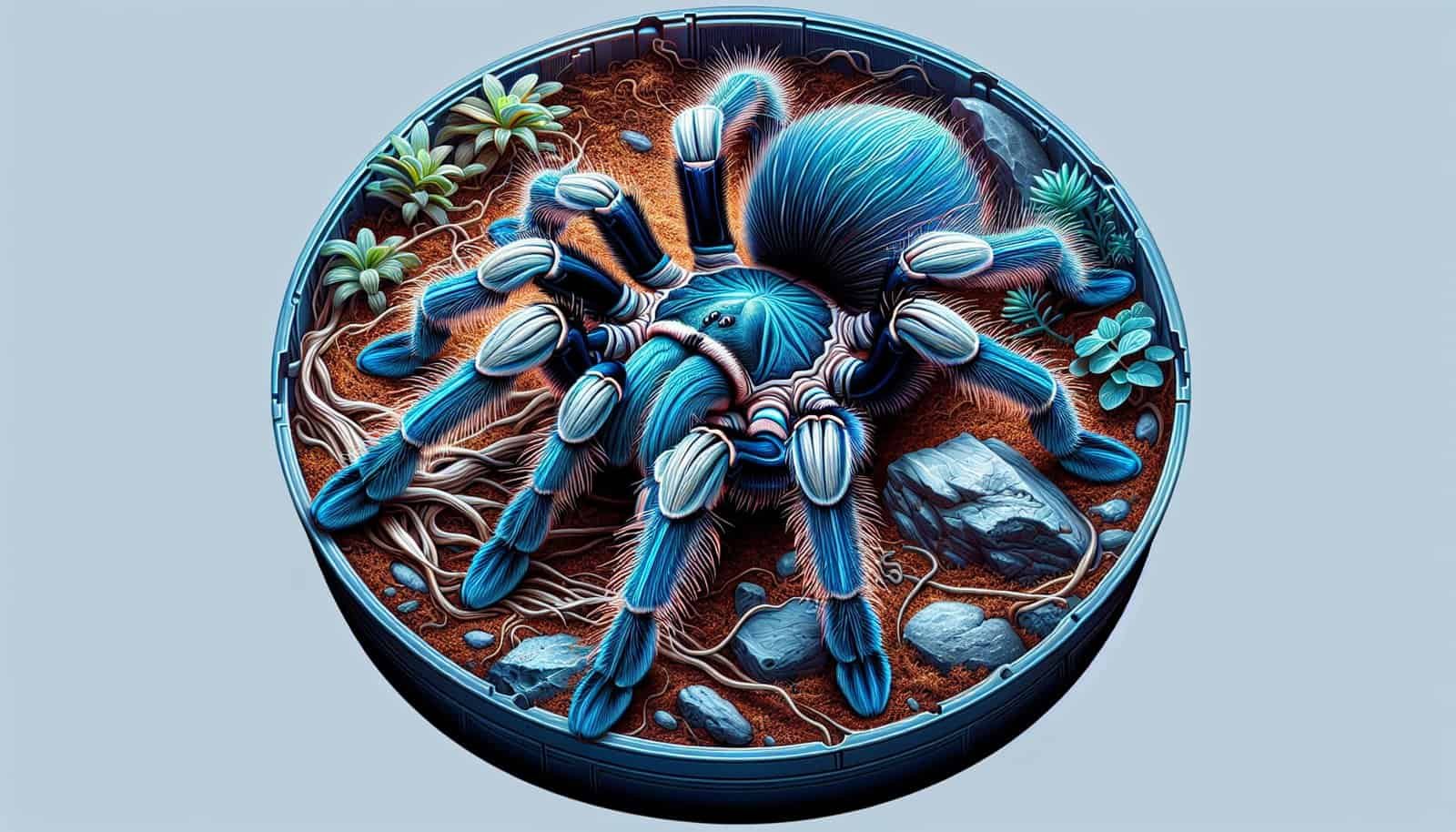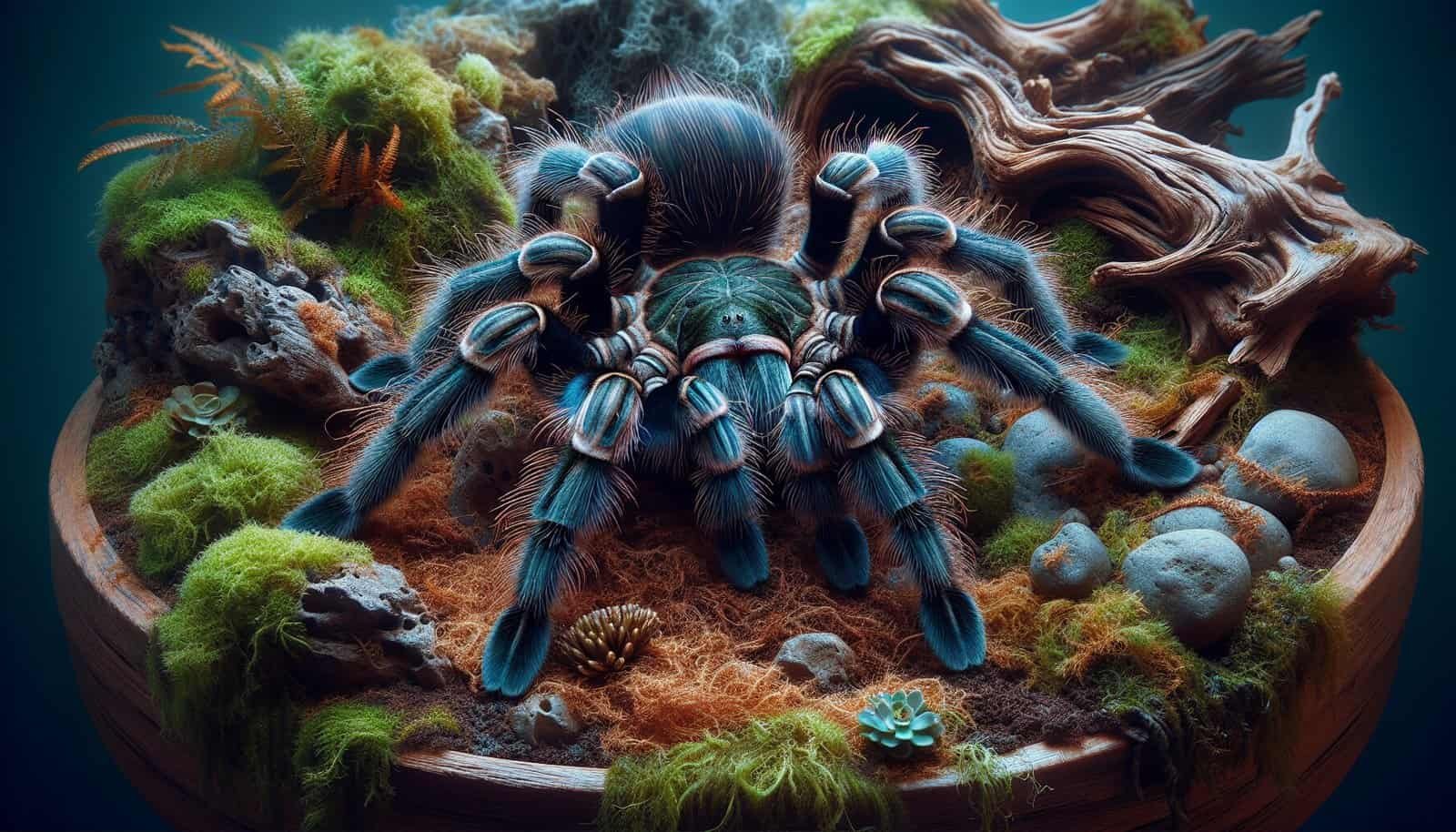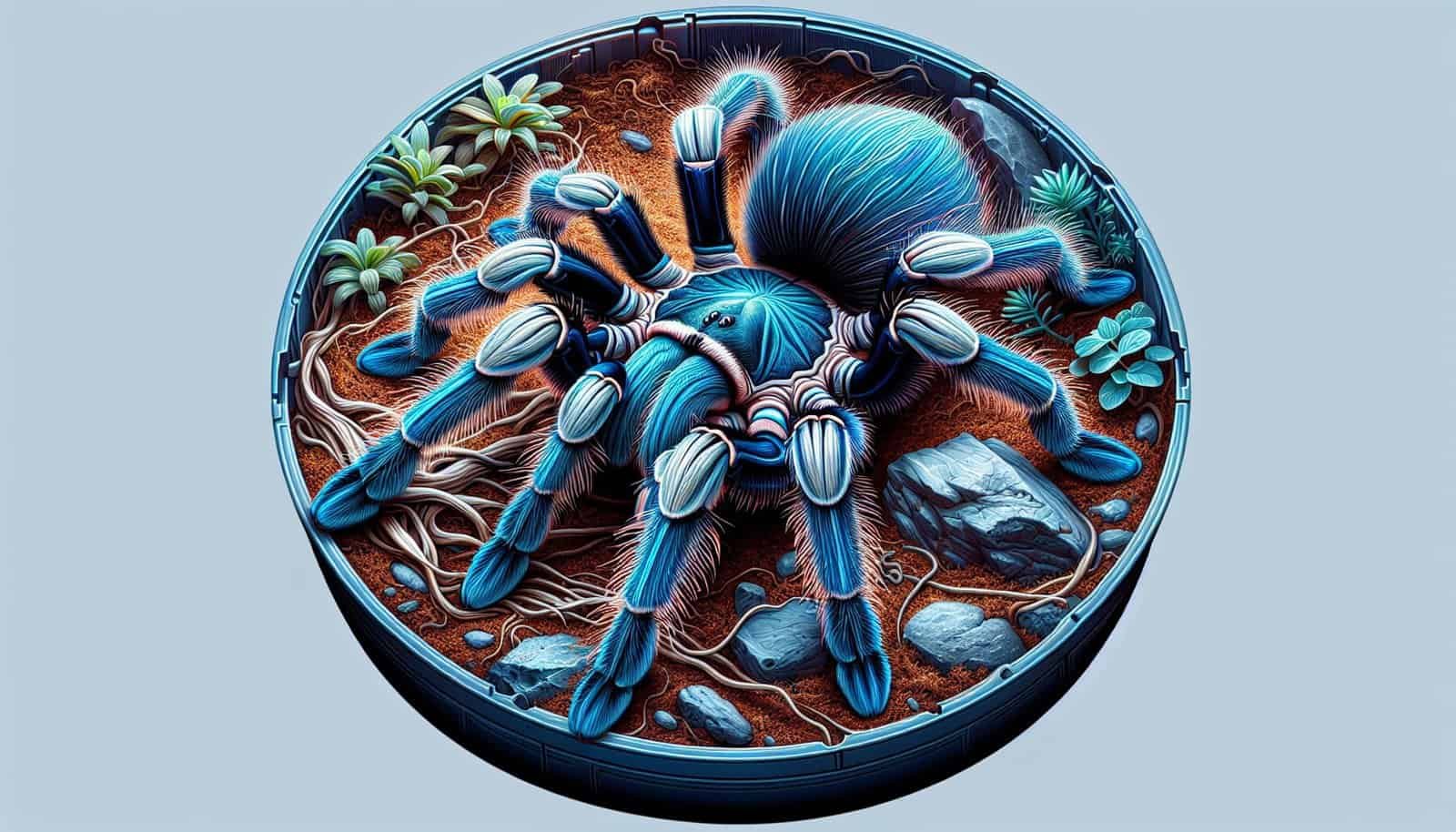Are you ready to learn the secrets of creating the perfect bioactive setup for the mesmerizing Metallic Blue Tarantula? In this article, we will explore everything you need to know about providing a habitat that not only meets the spider’s needs but also brings out its natural charm. From choosing the right substrate and plants to creating a suitable temperature and humidity level, you’ll discover the key elements to transform your tarantula’s enclosure into a thriving and enchanting home. So, let’s dive into the world of the Metallic Blue Tarantula and uncover the secrets to creating a bioactive setup that will leave you and your eight-legged friend in awe!

Choosing the Right Enclosure
Size of the Enclosure
When it comes to choosing an enclosure for your Metallic blue tarantula, size is an important factor to consider. These creatures require sufficient space to move around comfortably and exhibit their natural behaviors. Ideally, the enclosure should have a base length and width that is at least three times the tarantula’s leg span.
Type of Enclosure
There are various types of enclosures available for tarantulas, including glass tanks, acrylic cages, and plastic containers. Each type has its own advantages and disadvantages. Glass tanks provide better visibility, while acrylic cages are lightweight and less prone to breaking. Plastic containers are affordable and easy to clean. Consider your personal preferences and the needs of your tarantula when choosing the type of enclosure.
Ventilation
Proper ventilation is crucial to maintaining a healthy environment for your Metallic blue tarantula. Without adequate airflow, the enclosure can become stagnant and lead to bacterial growth or respiratory issues for your pet. Look for enclosures with built-in ventilation holes or consider adding screened vents to ensure proper air circulation.
Accessibility
An easily accessible enclosure is essential for both you and your tarantula. Choose an enclosure with a secure yet convenient opening mechanism, such as hinged doors or sliding panels. This will make it easier for you to feed your tarantula, perform maintenance tasks, and observe your pet while minimizing the risk of escape.
Substrate Selection
Natural Substrates
Natural substrates, such as coconut fiber, peat moss, or a mixture of soil and sand, can create a more naturalistic and bioactive environment for your Metallic blue tarantula. These substrates mimic their natural habitat and allow them to exhibit their natural digging behaviors. Ensure that the selected substrate is free from pesticides or other harmful chemicals.
Artificial Substrates
If natural substrates are not readily available or preferred, artificial substrates can be used as an alternative. These include materials like reptile carpet, paper towels, or even artificial turf. While these substrates may not provide the same level of moisture retention as natural options, they are easier to clean and maintain. However, it’s important to ensure that the artificial substrate does not have any sharp edges that may harm your tarantula.

Providing Hiding Spots
Natural Hideouts
Creating hiding spots is essential for the well-being of your Metallic blue tarantula. These creatures typically seek shelter during molt and when they feel threatened. Natural hideouts, such as small cork bark pieces, hollow logs, or rock formations, provide a sense of security and mimic the natural environment of your tarantula. Place these hideouts strategically throughout the enclosure to give your tarantula options for privacy.
Artificial Hideouts
If natural hideouts are not readily available, artificial options such as commercially available tarantula hides or DIY hideouts made from PVC pipes or flowerpots can be used. These artificial hideouts should have a suitable size for your tarantula to comfortably hide and molt in. Ensure that the hideouts are secure and stable to prevent any accidents or injuries.
Creating a Suitable Temperature and Humidity
Temperature Range
Maintaining an appropriate temperature range is crucial for the overall health and well-being of your Metallic blue tarantula. These tarantulas thrive in temperatures between 70°F to 85°F (21°C to 29°C), with slightly cooler temperatures at night. Use a thermometer to monitor the temperature inside the enclosure and consider using a heating pad or heat lamp to achieve and maintain the desired temperature range.
Humidity Levels
Humidity is another important factor to consider when creating a bioactive setup for your tarantula. Metallic blue tarantulas require a humidity level of around 60% to 70%. This can be achieved by misting the enclosure regularly with water or by placing a shallow water dish inside the enclosure. Monitoring the humidity levels using a hygrometer is recommended to ensure it remains within the optimal range.
Using Heat and Humidity Sources
To maintain the suitable temperature and humidity levels, you can use heat pads, heat lamps, or ceramic heat emitters. These heat sources can provide the necessary warmth without directly exposing your tarantula to high heat. Additionally, misting the enclosure daily with water can help maintain the desired humidity level. It’s important to carefully monitor and adjust these heat and humidity sources to prevent your tarantula from being exposed to extreme conditions.

Lighting Requirements
Natural Lighting
While tarantulas do not require specific lighting as they are primarily nocturnal creatures, providing access to natural lighting can benefit their overall well-being. Placing the enclosure in a well-lit room or near a window allows for a natural day and night cycle, which can help regulate their biological rhythms. However, direct sunlight should be avoided as it can cause overheating and potentially harm your tarantula.
Artificial Lighting
Artificial lighting is not essential for tarantulas but can be used to enhance the visual appeal of the enclosure. You can opt for low-intensity LED lights or UV lights designed for reptile enclosures. These lights can create a subtle ambiance and highlight the natural beauty of your Metallic blue tarantula. Remember to provide a dark hiding spot in the enclosure so your tarantula can retreat and rest during the day.
Furnishing the Enclosure
Branches and Climbing Decor
Adding branches or climbing decor to the enclosure provides your Metallic blue tarantula with opportunities to engage in its natural arboreal behaviors. Secure branches horizontally or vertically to mimic trees in their natural habitat. These climbing structures not only provide mental and physical stimulation but also create additional resting places for your tarantula.
Leaf Litter and Foliage
Adding leaf litter and foliage to the enclosure can create a more natural and aesthetically pleasing environment. Use dried leaves from non-toxic plants, such as oak or magnolia, to create a layer of leaf litter. This not only mimics the forest floor but also provides hiding spots and encourages natural behaviors. Additionally, artificial plants or silk foliage can be added to enhance the overall visual appeal of the enclosure.
Water Dish
Providing a shallow water dish in the enclosure is essential for maintaining hydration for your Metallic blue tarantula. The dish should be filled with clean, chlorine-free water. Ensure that the water dish is shallow enough for your tarantula to access easily without the risk of drowning. Regularly clean and refill the water dish to ensure a fresh and safe water source for your pet.
Feeding Dish
Feeding dishes can be used to offer food to your Metallic blue tarantula conveniently. These dishes should be shallow and easily accessible for your tarantula to reach its food without any obstructions. Cleaning the feeding dish after each meal will help maintain hygiene and prevent the growth of any unwanted mold or bacteria.

Selecting Suitable Tankmates
Compatible Species
Tankmates can add to the visual appeal of your tarantula enclosure and create a more dynamic habitat. However, not all species are suitable to coexist with tarantulas. Consider species that have similar environmental requirements and are not aggressive towards tarantulas. Some suitable tankmates may include certain species of millipedes, isopods, or certain types of frogs. Research thoroughly and consult with experts to ensure compatibility before introducing any tankmates.
Avoiding Aggression
It’s important to note that tarantulas are solitary creatures and may display aggression towards other animals. Avoid adding tankmates that are known to be antagonistic or predatory towards tarantulas. Observing the behavior of both the tarantula and potential tankmates before introducing them into the enclosure is crucial to prevent any injuries or fatalities.
Feeding the Tarantula
Finding the Right Diet
When it comes to feeding your Metallic blue tarantula, it’s important to offer a varied diet that mimics their natural feeding habits. These tarantulas are opportunistic hunters and primarily feed on live insects. Crickets, roaches, mealworms, and even small mice can be offered as a source of nutrition. Ensure that the prey items are appropriately sized for your tarantula to prevent choking or injury.
Feeding Schedule
Establishing a feeding schedule for your tarantula is essential to maintain its health and prevent overfeeding. Adult Metallic blue tarantulas can be fed once every one to two weeks, while juveniles may require more frequent feedings. Observe your tarantula’s eating habits and adjust the feeding schedule accordingly. Uneaten prey items should be removed from the enclosure to prevent them from harming your tarantula or affecting the cleanliness of the enclosure.

Maintaining Cleanliness
Regular Spot Cleaning
Regular spot cleaning of the enclosure is necessary to maintain a clean and hygienic environment for your Metallic blue tarantula. Remove any uneaten prey items, shed skin, and feces promptly to prevent the growth of bacteria or other harmful organisms. Use a spot-cleaning tool, such as tweezers or a gentle suction device, to remove debris without disturbing your tarantula.
Full Substrate Replacements
Periodically, a full substrate replacement is needed to ensure the overall cleanliness and well-being of your tarantula. Depending on the size of your tarantula and the size of the enclosure, this may vary from several months to a year. Before replacing the substrate, carefully transfer your tarantula to a temporary holding container and thoroughly clean the enclosure. Use the appropriate type of substrate mentioned earlier and ensure that it is properly hydrated before reintroducing your tarantula.
Monitoring the Tarantula’s Health
Behavioral Observations
Observing your Metallic blue tarantula’s behavior is an effective way to monitor its health. Look out for changes in activity levels, loss of appetite, abnormal posture, excessive grooming, or any signs of distress. These behaviors may indicate underlying health issues or stress. Regularly documenting your tarantula’s behavior can help identify any changes quickly and seek appropriate veterinary care if necessary.
Common Health Issues
Metallic blue tarantulas are generally hardy creatures; however, there are a few health issues to be aware of. Mites, fungal infections, and dehydration are some common health concerns. Regularly check your tarantula for any signs of parasites, such as tiny moving dots or webbing on its body. Provide a suitable humidity level and fresh water to prevent dehydration. If you notice any concerning symptoms, seek advice from a reptile or arachnid veterinarian experienced in tarantula healthcare.
Regular Veterinary Check-ups
Just like any other pet, regular veterinary check-ups are essential for the well-being of your Metallic blue tarantula. Find a veterinarian who specializes in arachnids or reptiles and schedule regular visits to ensure your tarantula’s health is monitored and any potential health issues are addressed promptly. Routine examinations, fecal tests, and general health assessments can help catch any health concerns at an early stage and ensure your tarantula lives a long and healthy life.
Creating a bioactive setup for your Metallic blue tarantula involves careful consideration of its enclosure, substrate, hiding spots, temperature and humidity, lighting, furnishings, tankmates, feeding, cleanliness, and health monitoring. By providing a suitable and enriching environment, you can ensure your tarantula thrives and showcases its natural behaviors while being a fascinating addition to your home. Remember to research thoroughly, seek expert advice when needed, and most importantly, enjoy the journey of caring for your charismatic pet tarantula.
